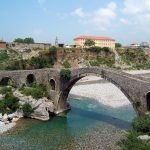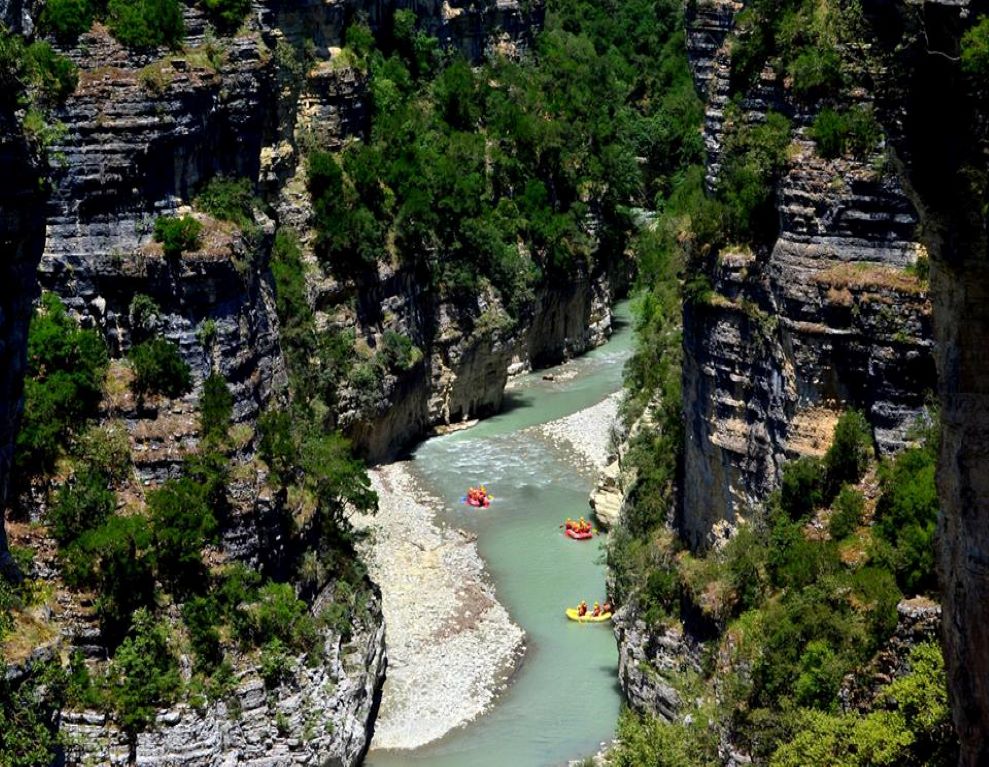
Albanian Canyons: Top 10 Canyons to Traverse in Albania
Among many natural attractions across the country, Albanian canyons provide lots of opportunities for travelers in search of unique adventurers. In this piece, we highlight Albania’s most attractive canyons; raising awareness in favor of the preservation of such formations.
1. Osum Canyon
The majestic canyon of Osum River is the largest in the country, rightfully deemed “Albania’s Grand Canyon”. It stretches for 13 km (8 miles) in the Çorovodë – Hambull section of the river valley, varying in width from 4 to 35 meters (13-115 feet). The playful and capricious stream meanders through thick, tall slopes, sitting on a water basin of some 70-80 meters (230-262 miles).
The best way to immerse yourself in the fantastic world of the Osum’s Canyon is to go through it by canoe or rafting boat. Cold watercourses, sideline waterfalls, gleaming leaves; all fused into an adventurous, precipitating stream. Such an experience into the canyon of Osum River is a must for water sport enthusiasts who can benefit from several professional local guides.
The beautiful journey of the canyon finishes at the Vau i Grepckës where it’s replaced by a wide-open delta used by the locals for summer baths.

2. Lengarica Canyon
The Lengarica Canyon stretches in one of the most attractive areas in the nation. Centuries of water erosion have formed stunning limestone formations of rare beauty rising thickly for 30 meters (98 feet) above the canyon floor. The whole canyon reaches a distance of 4-5 kilometers (2.5-3.1 miles). It has a maximum height of 150 meters (492 feet).
The curative, pearl-like waters of the Lengarica River meander through the canyon’s spectacular rocks. The experience of hiking into the canyon completes a superb tourist package part of which is the crossing of the Katiut Bridge and a bath into the nearby thermal waters. The nearby stone village of Benje is another must-visit attraction close to the canyon.

3. Grunas Canyon
Canyon of Grunas is located in the southern part of the Theth National Park in northern Albania. The gorge is some two kilometers long and, at its narrowest part, 2-3 meters (6.5-9.8 feet) wide. Grunas Canyon resonates with an unmatched beauty in every season, having adequate water levels within at all times.
The flow of the canyon presents a challenge for watersport lovers and professionals alike. Thus, enthusiasts who wish to raft there should do so in an organized group and with assistance from local guides.

4. Holta’s Canyon
Canyon of Holta is a marvelous natural formation in south-central Albania, in the area of Gramsh. Though close to the capital, it remains largely unexplored. Yet, recent infrastructural improvements across the Gramsh country have increased the number of visitors in Holta.
Holta’s Canyon reveals nature to the visitors in it’s true and full form. Vertical cliffs, full of dense vegetation, shade the travellers as they cross the wet gully. Primitive wooden crossings, weird-shaped caves, and the emerald-coloured water make up for a memorable experience. Visitors should be cautious when they decide to traverse into the canyon as the water levels, in dynamic levels, rise rapidly.

5. Canyon of Llëngë
The Canyon of Llëngë-s near the village of Trebinjë in Pogradec is a precious natural attraction of the area. The defile is in the mountainous, remote micro-region of Mokrë, near the church of “Shën Marenë” dated in 1754. The region is an ideal destination for those staying in the lakeside town of Pogradec but seeking a different vacation experience nearby.
Also known as “Gryka e Gurit” (“Stone’s Gorge”), the canyon has moderate dimensions: 1 kilometer (0.6 miles) long and 15-20 meters (49-65 feet) wide. What makes it impressive is that it sinks dramatically for 50-60 meters (164-197 feet) into the landscape. It’s for this beautiful contrast that the location has attracted many visitors and adventures.
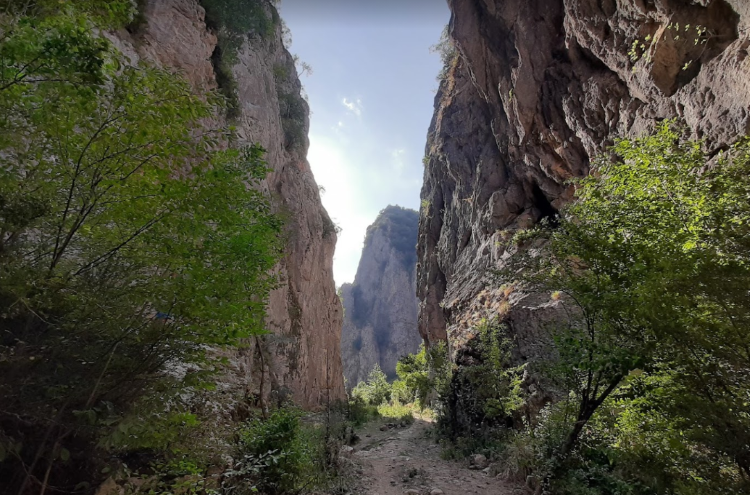
6. Canyon of Brar
Canyon of Brar, formed by the River of Tirana, confines the base of the Dajti Mountain. The smooth, colorful gorge begins at the old stone bridge of Brar, present in the area since the XVIII century. The gorge is largely irregular, forming a maze filled with beautiful natural chambers and inlets.
The path formed by the Canyon of Brar has been used throughout history for linking the Tirana plain with the eastern highlands. As such, this route bears the marks of daring local armies marching to protect their lands against invaders such as the Romans and the Ottomans. Nowadays, the area attracts plenty of hikers, country cyclers, and outdoor enthusiasts searching for a quick gateway out of the city buzz.
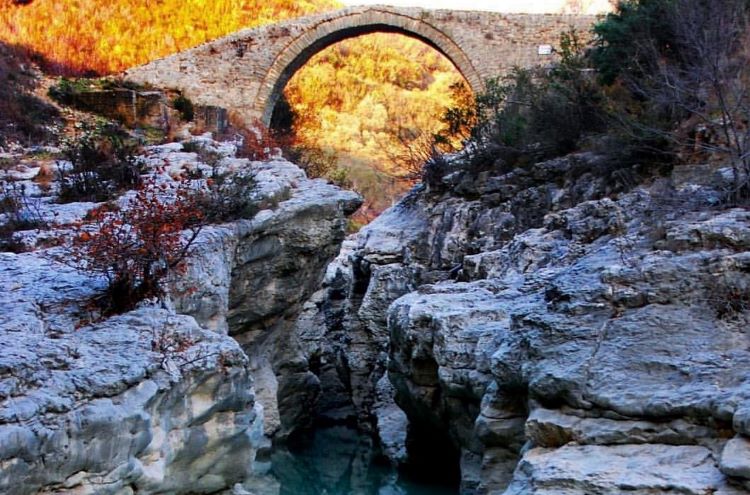
7. Canyon of Gradec
The canyon of Gradec was formed millions of years ago by the collapse of the ceiling covering what was once the subterranean karstic passage of the river of Çorovodë. Standing at an altitude of 250 meters (820 feet) above sea level, the canyon ranges in depth from 100 to 200 meters (328-656 feet). The canyon floor is highly irregular, with deep sinks here and there and large rock blocks detached from the steep side cliffs. The average width here ranges from 10 to 15 meters (33-50 feet).
In several places, the slopes along the canyon are ideal for practicing rope, alpine climbing. To get to the canyon of Gradec, one must follow the rural road Çorovodë–Gradec.

8. Canyon of Lumit të Zezës
Not far from Nikël in Fushë-Krujë, you’ll find the canyon of Lumit te Zezës (Canyon of the Black River). The canyon stretches into a mountainous terrain but its floor is free from barriers and convenient for pleasant hiking. Most enthusiasts begin their hike near a stone bridge with a single arch believed to date back some 300 years.
The pleasant hike turns into a place of wonderlands as one continues to follow the canyon path pierced by Lumi i Zezës. In several places, you’ll find natural pools of crystal clear water, perfect for summer baths in the open. In other places, the canyon escapes underground following narrow waterfalls. The whole area remains untouched by human activity and filled with pastoral sceneries.

9. Canyon of Menikut
Canyon of Menikut is one of the many natural wonders of east-central Albania, located 3 kilometers (1.8 feet) from the bridge of Bushtrica. The most stunning scenery is below the XVI century bridge of Prenit, standing at the narrowest part above an abyss thirty meters deep.
The canyon, a natural pride of Librazhd region, is a typical Albanian gorge: a shallow stream cutting through sharp narrows with Mediterranean vegetation spots.
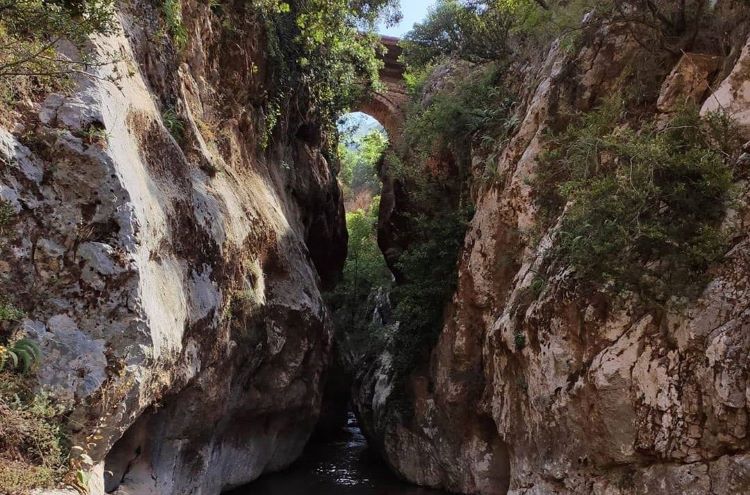
10. Canyon of Poicë
Rather than a typical Mediterranean canyon, Poica offers a fairytale view hard to find elsewhere. The canyon of Poicë is not a continuous formation, running in an irregular fashion for about 40 kilometers (25 miles). Even though it stretches in one of the areas with the heaviest rainfall in the country, its floor is usually dry.
The canyon begins in the legendary, alpine mountains of Shalë and Dukagjin, goes right through the valley of Shkreli, and finalizes its journey in the Lake of Shkodra. The deepest section is in the Dedaj village (50-60 meters/164-197 feet) while the narrowest part is in Poicë. Here, the karstic formations form enchanting natural chambers with mesmerizing refractions of light.




